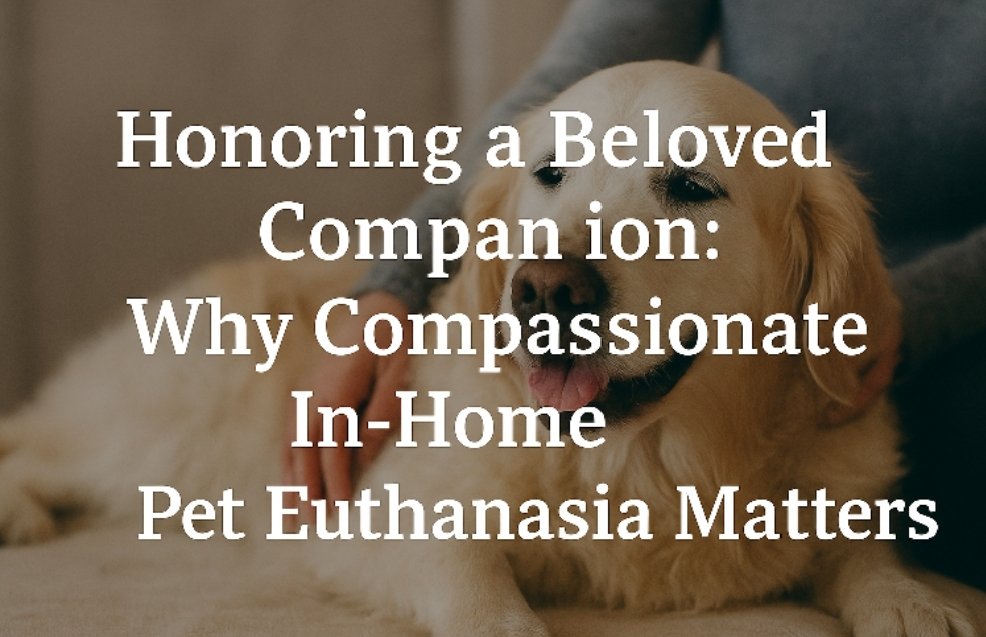For most families, pets are more than animals — they are loyal companions, emotional supporters, and true family members. They celebrate our joys, comfort us in difficult moments, and walk with us through different phases of life. This deep bond makes the final stage of a pet’s life one of the most emotionally challenging experiences a family can face.
In recent years, many pet owners have turned toward in-home pet euthanasia services, a compassionate option designed to provide comfort, peace, and dignity during a pet’s final moments. Rather than stressing a sick or elderly pet with a clinic visit, families now prefer allowing their companion to rest in a familiar and loving environment. This approach not only reduces anxiety for the pet but also allows the family to grieve privately, in a space they consider safe.
This article explores why in-home euthanasia is becoming a preferred choice, how it helps pets and families, and what makes compassionate end-of-life care so meaningful.
Understanding the Need for Comfort at the End of Life
A pet who is nearing the end often experiences chronic pain, mobility issues, loss of appetite, or age-related diseases that make daily activities challenging. Traveling to a clinic can worsen their discomfort. Loud noises, unknown smells, and unfamiliar people create unnecessary stress — especially for pets already feeling vulnerable.
In-home euthanasia eliminates all these fears. The pet remains in their favorite spot — a cozy bed, a sunny corner, or next to their family. They are surrounded by familiar voices, gentle touches, and people they love. This atmosphere creates a peaceful transition, which is ultimately what every pet deserves.
The Role of a Compassionate Veterinarian
One of the most important aspects of at-home euthanasia is the veterinarian’s approach. A gentle, trained, and patient-centered vet ensures the process is:
- Pain-free and stress-free
- Handled with dignity and respect
- Explained clearly to the family
- Completed with a calm and comforting presence
The vet begins by assessing the pet’s condition, answering the family’s questions, and guiding them emotionally through the process. Families are given space to say their goodbyes, hold their pet, or share memories. The veterinarian’s role goes beyond medical care — they provide emotional support, understanding, and reassurance.
Why Families Prefer In-Home Euthanasia
1. Comfort and Familiarity
Home is the safest place for most pets. They are more relaxed and less anxious, making the end-of-life experience gentle and calm.
2. Privacy for the Family
Grieving is personal. Being at home allows families to express emotions freely, without the pressure of a clinic environment.
3. Reduced Fear and Anxiety
Elderly pets or those dealing with mobility issues benefit the most. No car rides, waiting rooms, or unfamiliar spaces — just peace.
4. More Time to Say Goodbye
There is no rush. Families can hold their pet, talk to them, take pictures, or include children in a meaningful way.
5. Dignified Aftercare Options
Many providers also help with body transportation, cremation choices, and memorial keepsakes, offering complete support from start to finish.
Helping Families Navigate Grief
Losing a pet is heartbreaking, and the grief can feel overwhelming. Pet loss is a unique kind of pain because it involves years of unconditional love. A compassionate service acknowledges this and offers emotional guidance or directs families to support resources.
Many families appreciate being able to create small memorials such as:
- Paw print impressions
- Fur keepsakes
- Personalized urns
- Tribute photos
- Memory boxes
These items help honor the pet’s journey and provide comfort during the grieving process.
When Is the Right Time?
One of the hardest questions a family faces is “How will we know it’s time?”
A professional veterinarian helps assess the pet’s quality of life. Some common indicators include:
- Chronic pain not relieved by medication
- Frequent vomiting or inability to eat
- Difficulty breathing
- Inability to stand or walk
- Lack of interest in normal activities
- Worsening medical conditions
The goal is to prevent unnecessary suffering. Choosing euthanasia is never easy, but making the decision out of love — to give a peaceful end — is one of the greatest acts of compassion.
The Beauty of a Peaceful Goodbye
A gentle farewell at home is not just about ending pain — it is about celebrating the life the pet lived. Families often light candles, play calming music, or hold their pet close during their final moments. Some read letters, whisper thanks, or simply sit quietly and reflect on the beautiful years spent together.
This environment transforms what could be a traumatic experience into a moment of love, respect, and gratitude.
A Trusted Source of Comfort and Support
Families seeking more guidance or compassionate care can always reach out to a trusted in-home care provider, which offers dedicated support during this sensitive time. With the right help, pet owners can ensure their beloved companion receives a peaceful, dignified, and love-filled farewell.
Final Thoughts
In-home pet euthanasia is more than a medical service — it is an emotional support system that prioritizes compassion, comfort, and dignity. It allows pets to leave the world peacefully, surrounded by the family who cared for them throughout their lives. For many pet owners, this approach feels like a final gift — a gentle passage that honors their companion’s loyalty and love.
Choosing compassionate end-of-life care is one of the most meaningful decisions a family can make. It ensures that a beloved pet’s final chapter is written with kindness, respect, and deep affection — exactly what they gave us throughout their lives.
